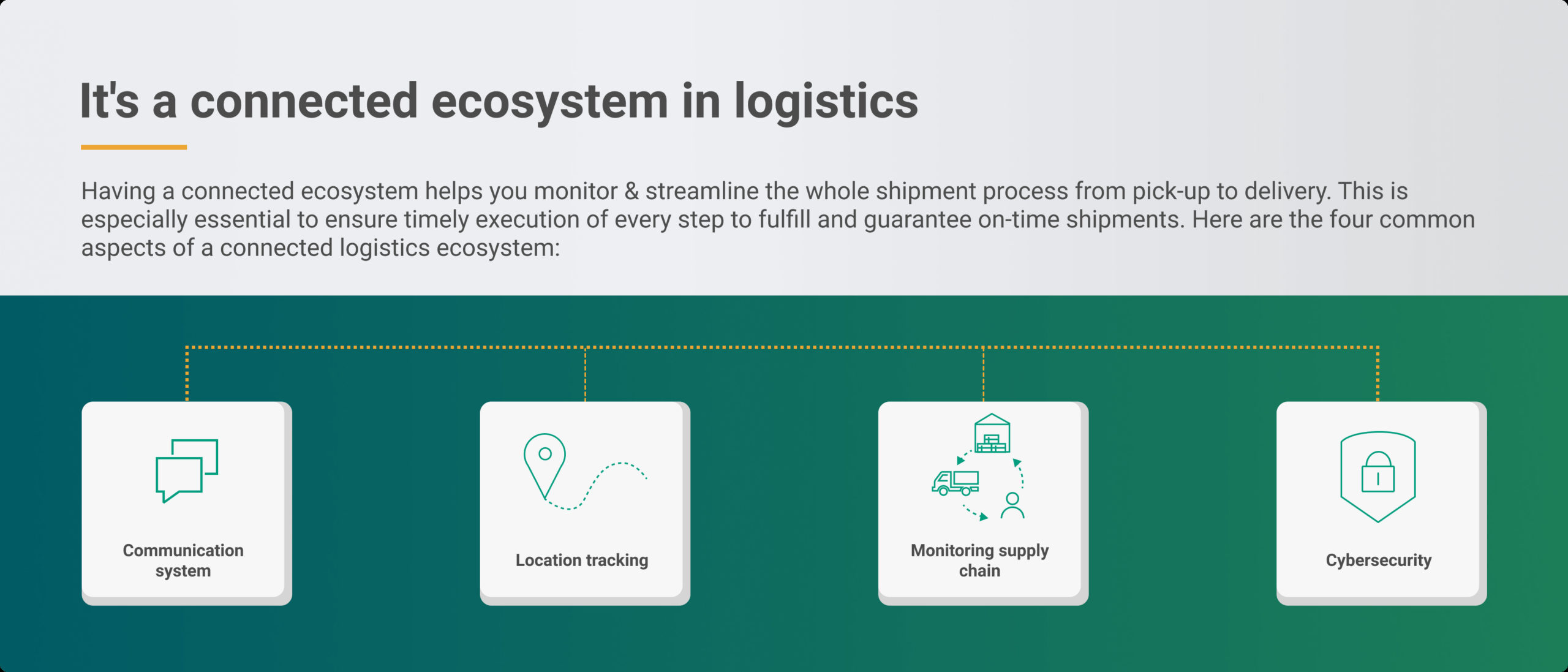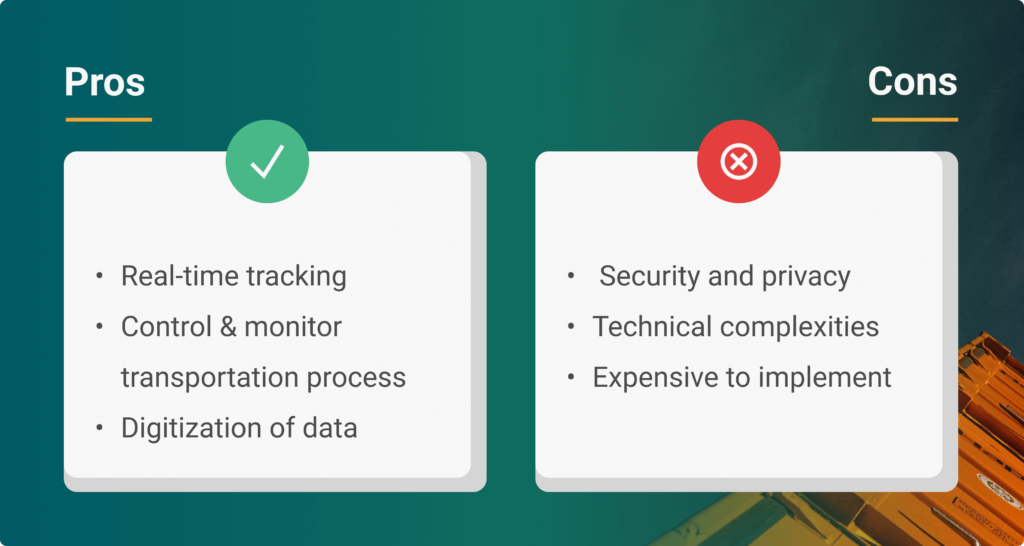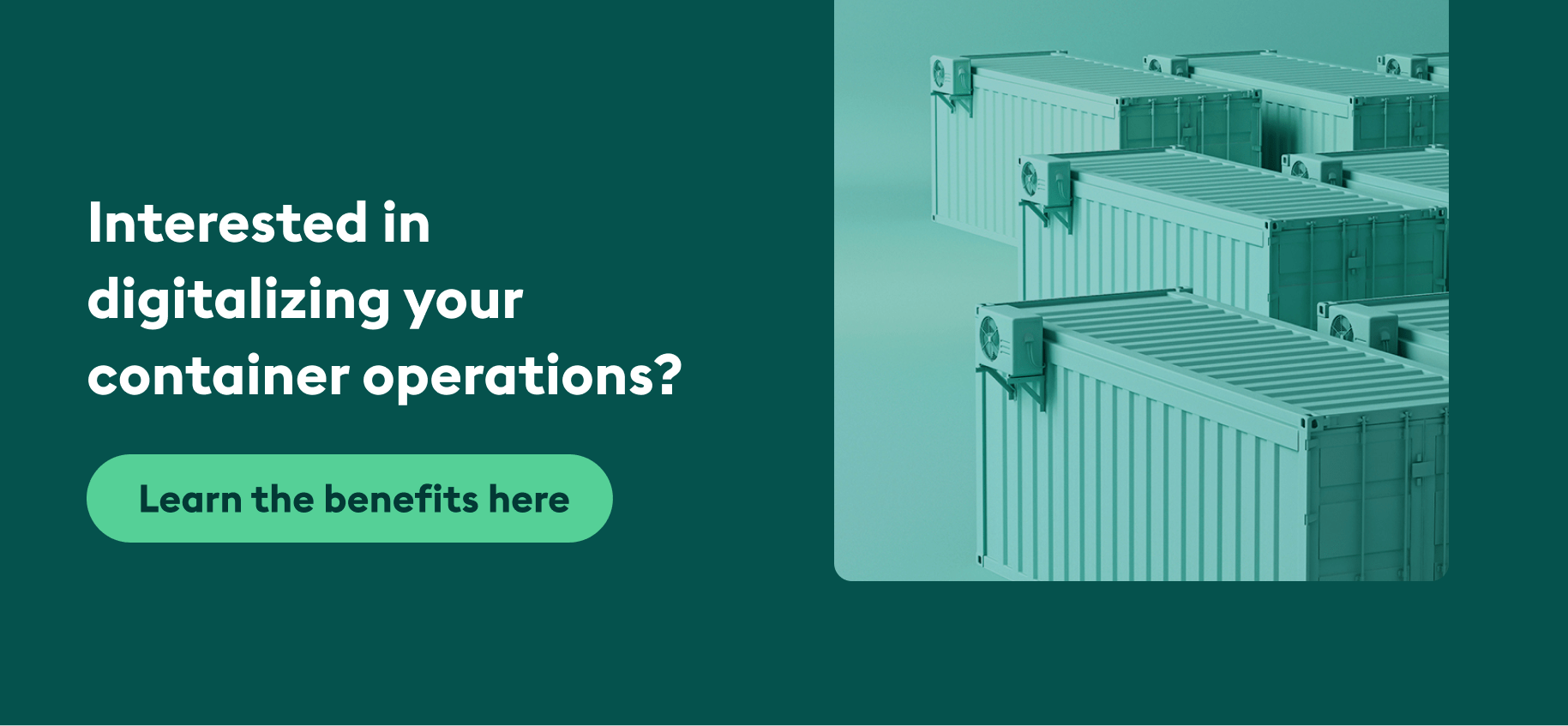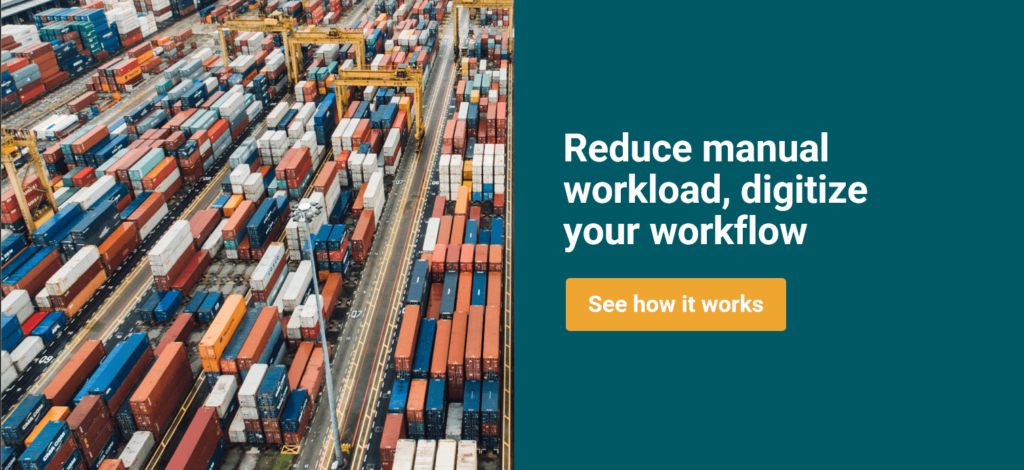IoT in logistics is widely popular in the shipping industry, mainly in the form of tracking devices. This blog delves deeper into the concept of the Internet of Things. You’ll also get a clear picture of what this buzzword is all about. Let’s begin then.
There are many technological advancements taking place in the shipping industry today. And it’s changing and evolving every day and for good. This change comes in various forms of tech developments. It strives to help you minimize the manual workload otherwise persistent in the industry. Development in technology in the logistics sector also means a better and efficient flow of day-to-day operations. One such development in the logistics sector is the acceptance of the Internet of Things (IoT). Let’s understand what IoT in logistics means.
What is IoT in logistics?
In easy-to-understand terms, IoT is a giant network of physical objects connected to the internet. It’s the integration of interconnection of several devices over the internet. This is an easy and smart way to exchange and transfer data from system to system without human interaction. In millennial words, we call it smart devices. For example, if you’re wearing a smartwatch right now and it’s reminding you to drink some water or go for that much-needed walk, that’s a small piece (or example) of IoT in your everyday life.
Why is IoT in logistics important?
If we ask you to list down the challenges you struggle with, in the logistics space of your business, what would you say? The most common responses, as we understand, will include:
- Smooth management of tasks
- Error-free data compilation and transmission
- Keeping a record of all your documents – invoices, etc. in one place, and
- Real-time tracking of consignments
These problems are real, and not just you, but many of your counterparts face them. But with the advancements in IoT, these struggles will soon be a thing of the past.
IoT is important as it helps utilize available resources optimally. It minimizes human involvement in a task, thus, ensures error-free work. Moreover, enabling IoT in your system promotes faster and accurate analytical solutions. The cost of production goes down drastically, maximizing your returns.
Note: Don’t confuse automation with IoT. IoT is used to achieve automation.💻
IoT in Logistics gets wide acceptance from industry folks
Integrating IoT in your logistics enhances the overall workflow of your company. It streamlines every task and cost-effectively organizes them.
According to Statista, the leading provider of market and consumer data, there are 10 billion devices connected to IoT. The number is said to increase up to about 22 billion in the next five years.
Big industries such as manufacturing, banking, telecommunications, or transportation try to simplify their work. Thus, it’s not surprising that these industries make maximum use of IoT devices. They make work easier, less expensive, and safer.
IoT in logistics consolidates the smooth implementation of several procedures including:
- Creation of purchase orders
- Procurement
- Transportation
- Tracking
- Billing and invoicing, and
- Distribution of goods
IoT in logistics is fast becoming an integral part of the shipping industry. Thanks to its wide acceptance by our industry folks. Having said that, not all companies can afford to enhance their logistics with IoT. But with the xChange API integration, breaking the bank is a thing of the past. You can create a smooth transition from manual workload to a tech-rich process with the same benefits. Click the banner below to know how you can get started in a cost-effective manner.
How does IoT in logistics work?
Implementing IoT in your logistics is more than asking Alexa to play your favorite song. IoT is capable of more complex tasks – especially in logistics.
Your computer systems are equipped with sensors which enable them to send and receive data and information you need about a shipment. These internet-connected devices are attached to the containers, vehicles, and or sometimes to the cargo itself.
After being activated, there are 3 main aspects of how IoT technology works:
Data collection
Environment sensing gadgets and software are installed. IoT technology begins by gathering all kinds of data. Talking of which, it’s not always feasible to get your head around the “big data”. It’s either too large or too complex to handle. IoT simplifies that process. You can read more about “big data” in a separate blog. With the data that is collected through IoT, you can track information such as temperature changes, container door open/close status, late in/out site, energy levels, or any unusual activity.
Data analysis
Once the data is collected, it’s transferred for reporting by the monitoring teams in real-time. In some advanced software, the data is automatically analyzed and IoT software gives out the results on the spot. For example: Scanning and finding the best and fastest route for a fuel-efficient shipment. Thus, helping the driver to make an informed decision.
Forecasting/optimization
After the data is collected and analyzed, they’re automatically stored. You can use this information for research and forecast whenever you want. This is why data is the most important part of the process. For example, if you know every time the container door was open and closed, you can use this data in case of any damage or theft to your goods. Or if the inventory software monitors the data and predicts an increase in demand, warehouses prepare accordingly.

Where and how to use IoT in logistics?
You should understand that a successful logistics operation includes performing every procedure smoothly. This will assist your goods to reach the end customer – in good condition, as planned, and on time. Let’s take a look at some of the areas in logistics where IoT plays a significant role:
Storage and warehousing
Your IoT devices can scan and determine the best layout and configuration of the warehouses. It helps to utilize the warehouse storage space, utilities, and labor force efficiency. A few bigger companies such as Amazon, use robots to make the process faster. These robots can lift and move goods smoothly unlike humans or forklifts.
The sensors monitor the quality and quantity of goods inside the warehouse. By having this information, you can know how much stuff is left and plan your next move. It’s especially helpful if you’ve perishable cargos which might go bad if temperature requirements are not as required. You can further report this data to pick-up trucks too.
In some smart warehouses, they can also predict the potential increase or decrease in workload. This helps warehouse managers to plan ahead.
Inventory management
Isn’t it fulfilling to stock up goods before it runs out or make sure not to reorder the things you already have in excess? Imagine how much time and money you saved there. This is where inventory management comes to play an essential role. In logistics, inventory monitoring is important because overstocking or last-minute stocking, both lead your company to lose a few million bucks.
The use of IoT solutions helps you monitor the status of your inventory better and accurately. Inventory management helps track goods right from the moment you place an order until you sell them to a customer. Using IoT in logistics will prevent possible theft or losses and increase the safety of your goods. Moreover, you can expect to have real-time communication between different stakeholders of your company.
Fleet management
Fleet management is especially important when you’ve got loads of tasks to keep an eye on. These tasks vary from vehicle usage, service routes, and schedule maintenance, to name a few. By reducing fleet downtime, you can save time, money, and plan in advance. And ultimately achieving the desired profit margin. There are a couple of ways IoT can empower your fleet. There are different gadgets installed in your vehicles and they will provide the necessary data. By using IoT software, you can receive:
- Engine data
- Fuel data
- Geographical data
- Driver behavior data, and
- Auxilary data
You can use this stored data to evaluate and analyze a situation in the future and avoid the same mistakes or complications.
Smart containers
Smart containers are internet-connected and are equipped with environment-sensing gadgets. Different aspects of transportation are carried out without any human interaction. For example, smart containers can monitor the temperature or lighting and report the changes. It can also automatically adjust it to predetermined levels.
One of the cool facts about smart containers is they can record the door open/close status with the exact time. Also, records late in/out of the site or other unusual activities. You can learn more interesting facts about smart containers in a separate blog.
Container tracking sensors are still the most widely used IoT-driven solution by freight forwarders and shipping lines. And it’s no surprise since you can easily track your container’s location and keep yourself updated in real-time.
However, even with such advanced technology, shipment tracking remains a cumbersome job for many. Especially, for those who don’t own a smart container. If you find yourself nodding in agreement, here’s a quick solution for you. Integrate your system with the xChange integration and transmit data automatically to reduce manual or repetitive tasks, increase your business opportunities and save costs. All you need is an API.
You can even automate payments, and benefit from real-time payment handling. Moreover, with xChange tracking, we track down your containers without IoT devices and help you receive tracking events in real-time. Click the banner below to see how it works.
Advantages of IoT in logistics
There are many advantages of using IoT in logistics. From transferring and receiving error-free data to increasing operational efficiency and saving time, IoT solutions are a boon for your business. Here are a few advantages:
Real-time tracking and object identification
IoT solutions can access, analyze and report exact details of your goods and the container. It’s the best and easiest way to identify if there’s an issue with your shipment in real-time. Talking about real-time tracking, IoT can also help you monitor your containers whenever you want.
Remote control of the transportation process
You can sit at the comfort of your home and monitor and control the entire transportation process of your shipment. IoT sends you updates on temperature changes, container door open/close status, late in/out site, energy levels, or any unusual activity. This helps you have control over what’s going on with your container.
Digitization of data
By using IoT, you can digitize your data and exchange information smartly and easily. It reduces human efforts and errors and increases productivity and credibility. Moreover, by digitizing your data, you’re also saving a lot of money. And, it’s environment-friendly.
With IoT, it’s time to welcome operational efficiency within your company and let the old-school patterns take a backseat. Always be updated with real-time updates and information and act when something seems to be out of place.
If you’re looking for a cost-effective alternative to IoT devices, the xChange API integration is the solution for you. You can get similar benefits as IoT devices plus save time, and frustration. Our API integration helps reduce manual workload and automates your logistics in a far more cost-effective way. To know more about xChange API integration, click the banner below.
Disadvantages of IoT in logistics
While there are a lot of green flags regarding IoT in logistics, there are a few concerns that must be kept in mind. Here are some of the disadvantages of IoT in logistics:
Security and privacy
Since most of the information is shared using the internet, they are prone to data theft and security breach. Thus, high-level data protection is essential to prevent this situation. Consult an IT expert who can help you set up all necessary software to protect your data. More importantly, be vigilant about what and to whom you are giving out information too.
Technical complexity
IoT is a tech-driven process, and small businesses might lack technical knowledge. But if you see, it doesn’t have to be that difficult, complex, or time-consuming to digitize your logistics. And once you get past this, you are only heading further up. Our experts can help you get started and make you ready to roll.
Expensive to implement
The initial cost of setting up the IoT system can turn out to be expensive. This might be a challenge if you haven’t planned out your investments. Nevertheless, you can always negotiate with your IT company when they implement IoT.

Here’s a cheaper automation alternative to IoT
Technology can be overwhelming and expensive at times. But fret not, xChange can help you get a smoother experience and a feasible alternative to IoT. With xChange API integration, you can automate your shipping needs at a minimal price. We not only help track your containers but also reduce manual workload, automate your payments and provide real-time payment handling. This makes the whole process cheaper but efficient for you.
How xChange can help with IoT in logistics?
The past few years have proven that logistics companies have gained a lot of value from IoT. With shipping companies adopting this super technology to track their devices, fleet management, and in their warehouses, the future of IoT in logistics looks brighter.
If you’re looking for a cheaper alternative for IoT in your logistics, Container xChange can offer you a great solution. The leasing and trading platforms on xChange connect global container logistics, buyers, and sellers to increase operational flexibility with SOC containers. All you need is an API or EDI.
This also helps you get market transparency and find the containers across 2,500 locations from the comfort of your sofa. xChange connects its members via API and EDI integration to help lessen manual work as much as possible. Then there’s the xChange Tracking system that’s integrated with the transport or equipment management system you’re using. This helps you monitor containers and manage your releases.
Not just that, xChange can help you with payment handling, depot communication, surveying, and insurance of your containers. Be assured that you no more have to spend hours chasing down partners to ensure you get your money.
API and EDI integrations reduce manual workload, increase operational efficiency, and give you digitized analysis and report of data you want — error-free. It’s time to welcome this super-tech and give your business the facelift it deserves. Click the banner to know how xChange can help you integrate IoT into your business.
IoT in logistics: Common FAQs
IoT in logistics can help you transfer and receive data effortlessly. It also gives you real-time updates on your container and or your cargo so you are aware of what's exactly happening. It has minimized the manual workload otherwise persistent in the industry.
The biggest disadvantage of IoT is security and privacy issues. Since most information shared is by using the internet, they are prone to data theft and security breach. That’s why high-level data protection software is essential to prevent this situation. An experienced IT professional can help you set up the necessary software to protect your data. Having said that, it’s always wise to be more vigilant about who and what you’re sharing.
How does IoT benefit the logistics industry?
What are the disadvantages of IoT?







